A Multi-Risk Approach to Climate Change Adaptation, Based on an Analysis of South Korean Newspaper Articles
Abstract
1. Introduction
1.1. Background
1.2. Climate Change Risk and Its Assessment
1.3. Media Coverage of Climate Change Issues
1.4. Research Hypotheses
- Climate change risk indicators and actual climate change impact data (from newspaper articles over 24 years) have a significant correlation.
- Based on the concept of climate change risk, the degree of risk can be quantified using climate drivers such as heatwaves and droughts.
- Some risk indicators in this study will have multi-risk characteristics that occur simultaneously during a climate change event.
2. Methods and Data
2.1. Climate Change Risk Indicators
2.2. Newspaper Articles: Analysis and Parametrization
2.3. Network Analysis
2.4. Research Process
3. Results
3.1. Frequency Comparison According to Risk Final Type
3.2. Analyzing and Comparing the Impact of the Multi-Risk Network
4. Discussion
4.1. Risk Assessment
4.2. The Multi-Risk Approach and Its Policy Uses
5. Conclusions
Author Contributions
Acknowledgments
Conflicts of Interest
References
- Ahchong, K.; Dodds, R. Anthropogenic climate change coverage in two canadian newspapers, the Toronto Star and the Globe and Mail, from 1988 to 2007. Environ. Sci. Policy 2012, 15, 48–59. [Google Scholar] [CrossRef]
- Boussalis, C.; Coan, T.G. Text-Mining the signals of climate change doubt. Glob. Environ. Chang. 2016, 36, 89–100. [Google Scholar] [CrossRef]
- Brüggemann, M.; Engesser, S. Beyond false balance: How interpretive journalism shapes media coverage of climate change. Glob. Environ. Chang. 2017, 42, 58–67. [Google Scholar] [CrossRef]
- Kleinschmit, D.; Sjöstedt, V. Between science and politics: Swedish newspaper reporting on forests in a changing climate. Environ. Sci. Policy 2014, 35, 117–127. [Google Scholar] [CrossRef]
- Kumpu, V. A climate for reduction? Futures imagined in newspaper coverage of UN climate summits. Futures 2013, 53, 53–62. [Google Scholar] [CrossRef]
- IPCC. Climate Change 2014: Impacts, Adaptation, and Vulnerability; World Meteorological Organization: Geneva, Switzerland, 2014. [Google Scholar]
- UNISDR. UNISDR Terminology for Disaster Risk Reduction. Available online: http://www.unisdr.org/files/7817_UNISDRTerminologyEnglish.pdf (accessed on 13 May 2018).
- Stern, N. The Economics of Climate Change: The Stern Review; Cambridge University Press: Cambridge, UK, 2007. [Google Scholar]
- Nam, W.; Choi, J.; Yoo, S.; Jang, M. A decision support system for agricultural drought management using risk assessment. Paddy Water Environ. 2012, 10, 197–207. [Google Scholar] [CrossRef]
- Yuan, X.; Wei, Y.; Wang, B.; Mi, Z. Risk management of extreme events under climate change. J. Clean. Prod. 2017, 10, 1169–1174. [Google Scholar] [CrossRef]
- Australian Greenhouse Office. Climate Change Impacts & Risk Management: A Guide for Business and Government; Department of the Environment and Heritage: Canberra, Australia, 2006.
- Brooks, N. Vulnerability, Risk and Adaptation: A Conceptual Framework; Working Paper; Tyndall Centre for Climate Change Research: Norwich, UK, 2003. [Google Scholar]
- Chen, K.Z.; Hsu, C. Managing climate change risk in China’s agricultural sector: The potential for an integrated risk management framework. J. Integr. Agric. 2014, 13, 1418–1431. [Google Scholar] [CrossRef]
- Defra. The UK Climate Change Risk Assessment: Government Report; Defra: London, UK, 2012.
- Xu, E.G.B.; Leung, K.M.Y.; Morton, B.; Lee, J.H.W. An integrated environmental risk assessment and management framework for enhancing the sustainability of marine protected areas: The cape d’Aguilar marine reserve case study in Hong Kong. Sci. Total Environ. 2015, 505, 269–281. [Google Scholar] [CrossRef] [PubMed]
- Zhou, Q.; Mikkelsen, P.S.; Halsnæs, K.; Arnbjerg-Nielsen, K. Framework for economic pluvial flood risk assessment considering climate change effects and adaptation benefits. J. Hydrol. 2012, 414–415, 539–549. [Google Scholar] [CrossRef]
- Alcantara-Ayala, I.; Altan, O.; Baker, D.; Briceno, S.; Cutter, S.; Gupta, H.; Holloway, A.; Ismail-Zadeh, A.; Jimenez Diaz, V.; Johnston, D. Disaster Risks Research and Assessment to Promote Risk Reduction and Management: Summary for Policymakers. Available online: http://www.iugg.org/policy/Report_RiskReduction_WCDRR_2015.pdf (accessed on 13 May 2018).
- Kang, Y.; Shin, J.; Park, C.S. Assessing climate change risk and adaptation policy improvements through text-mining. Urban Des. 2016, 17, 69–84. [Google Scholar]
- Bowles, D.C.; Butler, C.D.; Friel, S. Climate change and health in earth’s future. Earth Future 2014, 2, 60–67. [Google Scholar] [CrossRef]
- Boxall, A.B.A.; Hardy, A.; Beulke, S.; Boucard, T.; Burgin, L.; Falloon, P.D.; Haygarth, P.M.; Hutchinson, T.; Kovats, R.S.; Leonardi, G. Impacts of climate change on indirect human exposure to pathogens and chemicals from agriculture. Environ. Health Perspect. 2009, 117, 508–514. [Google Scholar] [CrossRef] [PubMed]
- Korea Ministry. 2nd National Climate Change Adaptation Plan; Korea Ministry: Seoul, Korea, 2015.
- Won, J.; Kim, D. Deduction of social risk issues using text mining. Crisisonomy 2014, 10, 33–52. [Google Scholar]
- Kim, J.H.; Park, D.J. A study on the review of risk concepts. J. Korean Soc. Saf. 2013, 28, 90–96. [Google Scholar] [CrossRef]
- Keller, C.; Siegrist, M.; Gutscher, H. The role of the affect and availability heuristics in risk communication. Risk Anal. 2006, 26, 631–639. [Google Scholar] [CrossRef] [PubMed]
- Kim, E.J. A study on environmental justice and risk regulation. Law Res. Inst. Hongik Univ. 2013, 14, 499–529. [Google Scholar]
- Antón, J.; Cattaneo, A.; Kimura, S.; Lankoski, J. Agricultural risk management policies under climate uncertainty. Glob. Environ. Chang. 2013, 23, 1726–1736. [Google Scholar] [CrossRef]
- Lawrence, J.; Reisinger, A.; Mullan, B.; Jackson, B. Exploring climate change uncertainties to support adaptive management of changing flood-risk. Environ. Sci. Policy 2013, 33, 133–142. [Google Scholar] [CrossRef]
- Fazil, A.M. A Primer on Risk Assessment Modelling: Focus on Seafood Products; FAO: Rome, Italy, 2005. [Google Scholar]
- Yoon, Y.G. A study on the risk assessment occurred possibly in a civil project. Explos. Blast. 2013, 29, 59–66. [Google Scholar]
- Kaplan, S.; Garrick, J.B. On the quantitative definition of risk. Risk Anal. 1981, 1, 11–27. [Google Scholar] [CrossRef]
- Brauner, C. Opportunity and Risks of Climate Change; Swiss Re: Zurich, Switzerland, 2002. [Google Scholar]
- Taylor, A.L.; Dessai, S.; Bruin, W.B. Public perception of climate risk and adaptation in the UK: A review of the literature. Clim. Risk Manag. 2014, 4, 1–16. [Google Scholar] [CrossRef]
- Eakin, H. Institutional change, climate risk, and rural vulnerability: Cases from central Mexico. World Dev. 2005, 33, 1923–1938. [Google Scholar] [CrossRef]
- Kreft, S.; Eckstein, D. Who suffers most from extreme weather events? Weather-related loss events in 2012 and 1993 to 2012. In Global Climate Risk Index 2014; Germanwatch: Bonn, Germany, 2013. [Google Scholar]
- Granderson, A.A. Making sense of climate change risks and responses at the community level: A cultural-political lens. Clim. Risk Manag. 2014, 3, 55–64. [Google Scholar] [CrossRef]
- Committee on Climate Change. UK Climate Change Risk Assessment 2017: Synthesis Report Priorities for the Next Five Years; Committee on Climate Change: London, UK, 2016. [Google Scholar]
- Gallina, V.; Torresan, S.; Critto, A.; Sperotto, A.; Glade, T.; Marcomini, A. A review of multi-risk methodologies for natural hazards: Consequences and challenges for a climate change impact assessment. J. Environ. Manag. 2015, 168, 123–132. [Google Scholar] [CrossRef] [PubMed]
- Sperotto, A.; Molina, J.L.; Torresan, S.; Critto, A.; Marcomini, A. Reviewing bayesian networks potentials for climate change impacts assessment and management: A multi-risk perspective. J. Environ. Manag. 2017, 202, 320–331. [Google Scholar] [CrossRef] [PubMed]
- Revi, A. Climate change risk: An adaptation and mitigation agenda for Indian cities. Environ. Urban. 2008, 20, 207–229. [Google Scholar] [CrossRef]
- Sperotto, A.; Torresan, S.; Gallina, V.; Coppola, E.; Critto, A.; Marcomini, A. A multi-disciplinary approach to evaluate pluvial floods risk under changing climate: The case study of the municipality of Venice (Italy). Sci. Total Environ. 2016, 562, 1031–1043. [Google Scholar] [CrossRef] [PubMed]
- Antilla, L. Climate of scepticism: US newspaper coverage of the science of climate change. Glob. Environ. Chang. 2005, 15, 338–352. [Google Scholar] [CrossRef]
- Boussalis, C.; Coan, T.G.; Poberezhskaya, M. Measuring and modeling Russian newspaper coverage of climate change. Glob. Environ. Chang. 2016, 41, 99–110. [Google Scholar] [CrossRef]
- Ford, J.D.; King, D. Coverage and framing of climate change adaptation in the media: A review of influential North American newspapers during 1993-2013. Environ. Sci. Policy 2015, 48, 137–146. [Google Scholar] [CrossRef]
- Irwansyah. What do scientists say on climate change? A study of Indonesian newspapers. Pac. Sci. Rev. B Humanit. Soc. Sci. 2016, 2, 58–65. [Google Scholar]
- O’Neill, S.J. Image matters: climate change imagery in US, UK and Australian newspapers. Geoforum 2013, 49, 10–19. [Google Scholar] [CrossRef]
- Pasquaré, F.A.; Oppizzi, P. How do the media affect public perception of climate change and geohazards? An Italian case study. Glob. Planet. Chang. 2012, 90–91, 152–157. [Google Scholar] [CrossRef]
- Schmidt, A.; Ivanova, A.; Schäfer, M.S. Media attention for climate change around the world: A comparative analysis of newspaper coverage in 27 countries. Glob. Environ. Chang. 2013, 23, 1233–1248. [Google Scholar] [CrossRef]
- Kirilenko, A.P.; Molodtsova, T.; Stepchenkova, S.O. People as sensors: Mass media and local temperature influence climate change discussion on Twitter. Glob. Environ. Chang. 2015, 30, 92–100. [Google Scholar] [CrossRef]
- Tranter, B.; Booth, K. Scepticism in a changing climate: A cross-national study. Glob. Environ. Chang. 2015, 33, 154–164. [Google Scholar] [CrossRef]
- Islam, M.M.; Barnes, A.; Toma, L. An investigation into climate change scepticism among farmers. J. Environ. Psychol. 2013, 34, 137–150. [Google Scholar] [CrossRef]
- Capstick, S.B.; Pidgeon, N.F. What is climate change scepticism? Examination of the concept using a mixed methods study of the UK public. Glob. Environ. Chang. 2014, 24, 389–401. [Google Scholar] [CrossRef]
- Jang, S.M.; Hart, P.S. Polarized frames on ‘climate change’ and ‘global warming’ across countries and states: Evidence from Twitter big data. Glob. Environ. Chang. 2015, 32, 11–17. [Google Scholar] [CrossRef]
- Liew, W.T.; Adhitya, A.; Srinivasan, R. Sustainability trends in the process industries: A text mining-based analysis. Comput. Ind. 2014, 65, 393–400. [Google Scholar] [CrossRef]
- Shen, L.; Yan, H.; Fan, H.; Wu, Y.; Zhang, Y. An integrated system of text mining technique and case-based reasoning (TM-CBR) for supporting green building design. Build. Environ. 2017, 124, 388–401. [Google Scholar] [CrossRef]
- Kim, J.; Choi, J.; Park, S.; Jang, D. Patent keyword extraction for sustainable technology management. Sustainability 2017, 10, 1287. [Google Scholar] [CrossRef]
- IPCC. Climate Change 2007: Synthesis Report; Contribution of Working Groups I, II and III to the Fourth Assessment Report of the Intergovernmental Panel on Climate Change; Core Writing Team, Pachauri, R.K., Reisinger, A., Eds.; IPCC: Geneva, Switzerland, 2007. [Google Scholar]
- Freeman, L.C. Social Network Analysis; SAGE: London, UK, 2008. [Google Scholar]
- Challinor, A.J.; Müller, C.; Asseng, S.; Deva, C.; Nicklin, K.J.; Wallach, D.; Vanuytrecht, E.; Whitfield, S.; Ramirez-Villegas, J.; Koehler, A. Improving the use of crop models for risk assessment and climate change adaptation. Agric. Syst. 2016, 159, 296–306. [Google Scholar] [CrossRef] [PubMed]
- Satta, A.; Puddu, M.; Venturini, S.; Giupponi, C. Assessment of coastal risks to climate change related impacts at the regional scale: The case of the Mediterranean region. Int. J. Disaster Risk Reduct. 2017, 24, 284–296. [Google Scholar] [CrossRef]
- Feulner, G. Global challenges: Climate change. Glob. Chall. 2017, 1, 5–6. [Google Scholar] [CrossRef]
- Hameed, S.O.; Holzer, K.A.; Doerr, A.N.; Baty, J.H.; Schwartz, M.W. The value of a multi-faceted climate change vulnerability assessment to managing protected lands: Lessons from a case study in point reyes national seashore. J. Environ. Manag. 2013, 121, 37–47. [Google Scholar] [CrossRef] [PubMed]
- Komendantova, N.; Mrzyglocki, R.; Mignan, A.; Khazai, B.; Wenzel, F.; Patt, A.; Fleming, K. Multi-hazard and multi-risk decision-support tools as a part of participatory risk governance: Feedback from civil protection stakeholders. Int. J. Disaster Risk Reduct. 2014, 8, 50–67. [Google Scholar] [CrossRef]
- Urwin, K.; Jordan, A. Does public policy support or undermine climate change adaptation? Exploring policy interplay across different scales of governance. Glob. Environ. Chang. 2008, 18, 180–191. [Google Scholar] [CrossRef]
- Adenle, A.A.; Ford, J.D.; Morton, J.; Twomlow, S.; Alverson, K.; Cattaneo, A.; Cervigni, R.; Kurukulasuriya, P.; Huq, S.; Helfgott, A.; et al. Managing climate change risks in Africa: A global perspective. Ecol. Econ. 2017, 141, 190–201. [Google Scholar] [CrossRef]
- National Institute of Environmental Research. 2050 Basic Research for Development of Climate-Friendly Safety Social Model; National Institute of Environmental Research: Seoul, Korea, 2012.
- Hu, Q.; He, X. An integrated approach to evaluate urban adaptive capacity to climate change. Sustainability 2018, 10, 1272. [Google Scholar] [CrossRef]
- UNDP. Adaptation Policy Frameworks for Climate Change: Developing Strategies, Policies and Measures; Cambridge University Press: Cambridge, UK, 2004. [Google Scholar]
- London Climate Change Partnership. Adapting to Climate Change Lessons for London; London Climate Change Partnership: London, UK, 2006. [Google Scholar]
- Ministry of Land, Japan. Practical Guidelines on Strategic Climate Change Adaptation Planning (Flood Disasters); Ministry of Land, Japan: Tokyo, Japan, 2010.
- Randey, R.; Kumar, P.; Archie, K.M.; Gupta, A.K.; Joshi, P.K.; Valente, D.; Petrosillo, I. Climate change adaptation in the western-Himalayas: Household levell perspectives on impacts and barriers. Ecol. Indic. 2018, 84, 27–37. [Google Scholar]
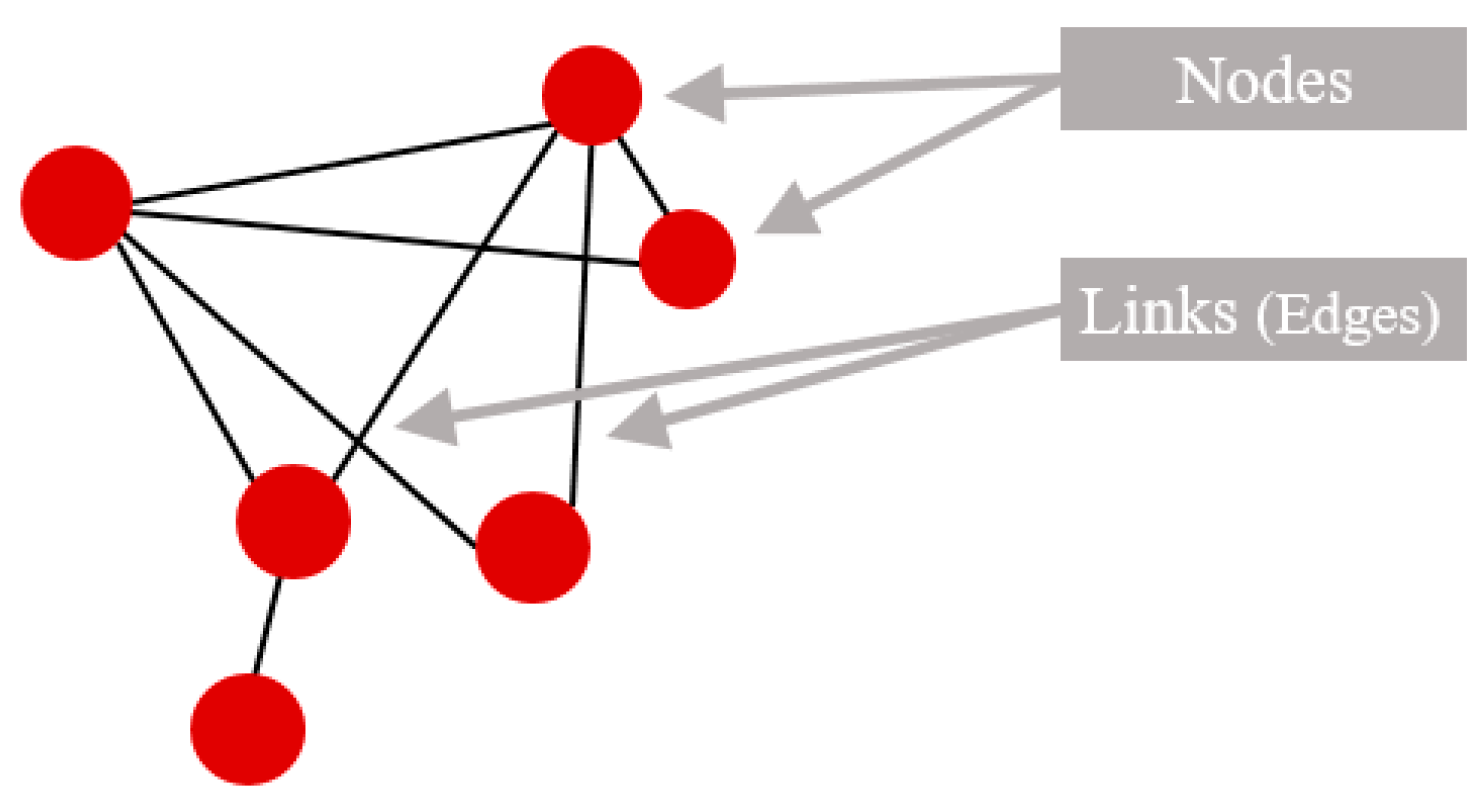
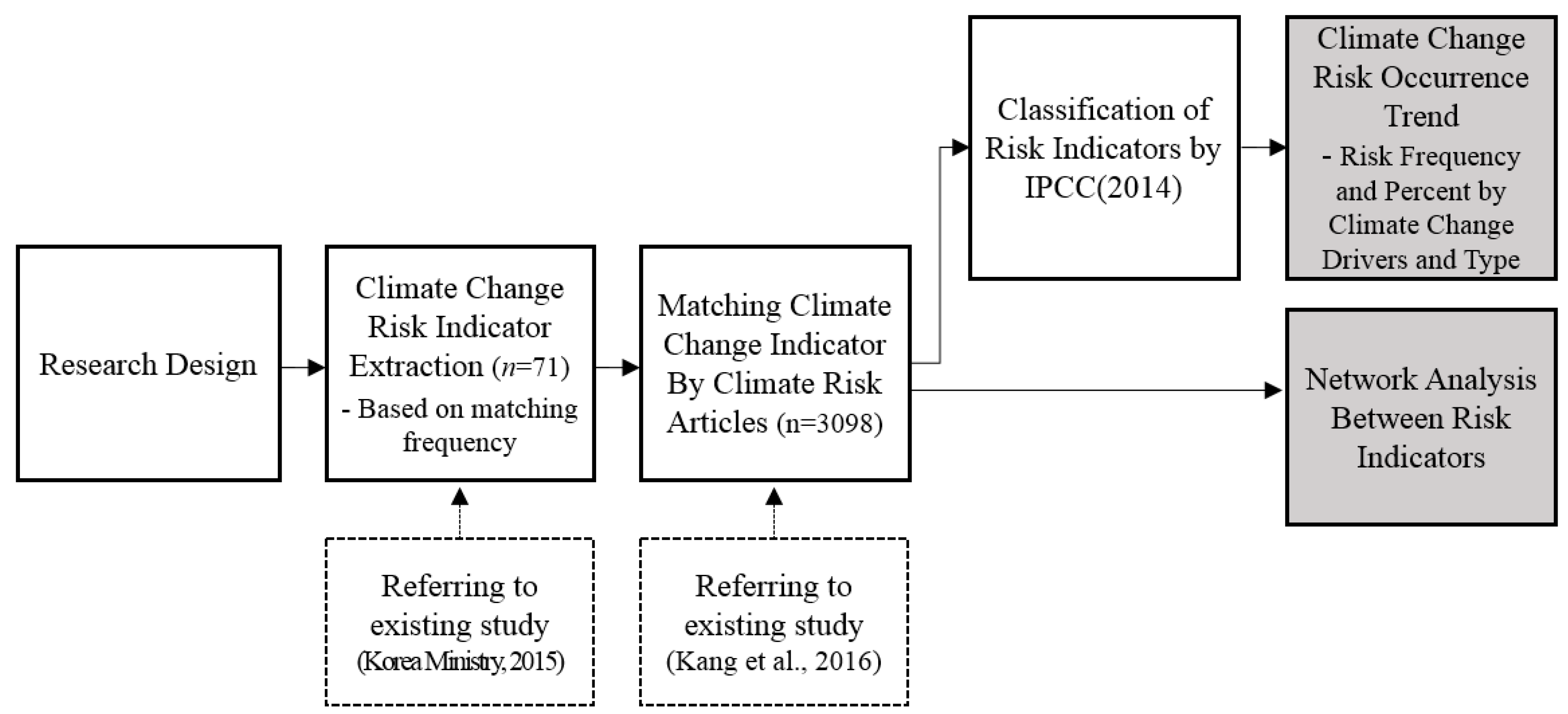
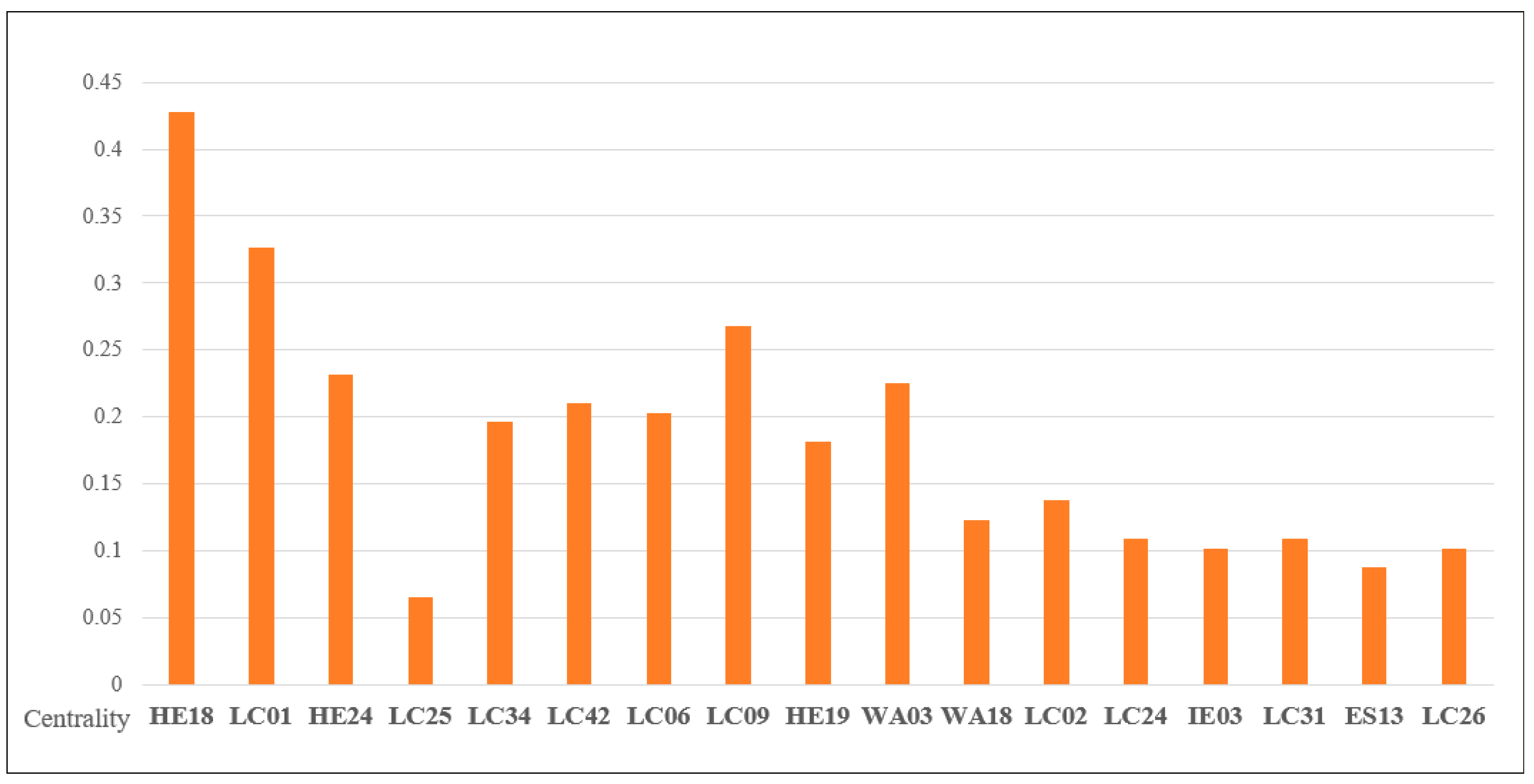
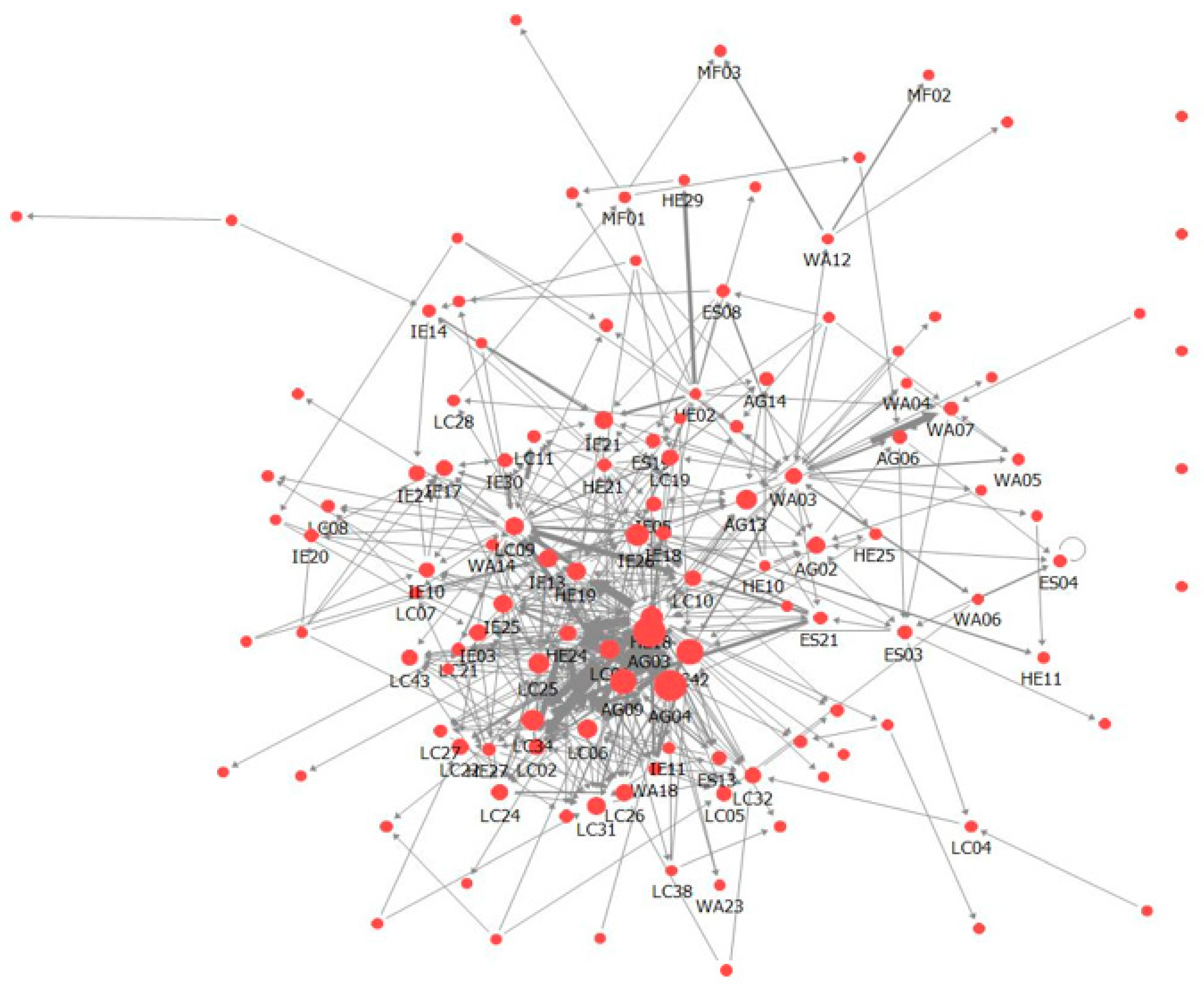
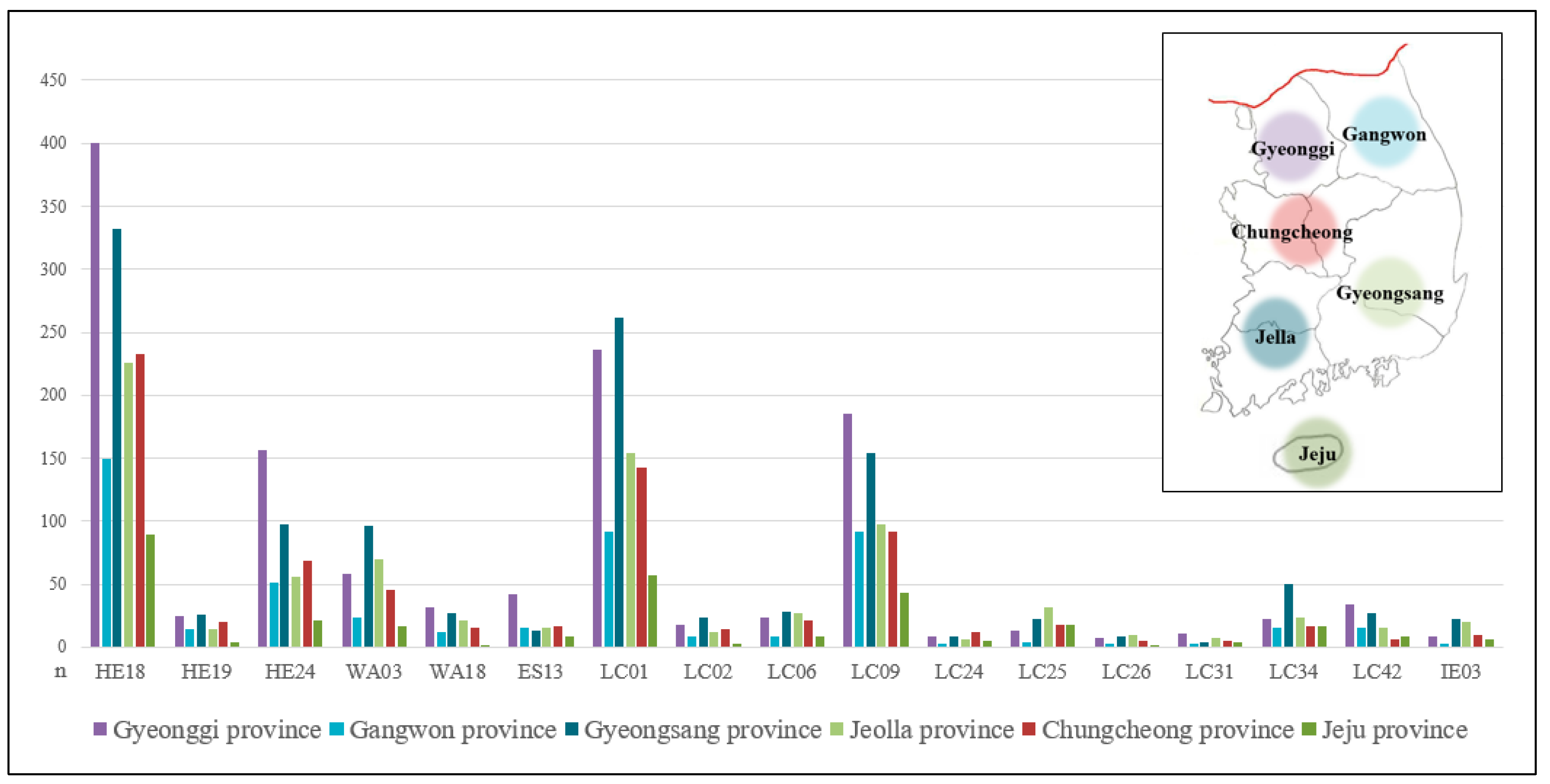
| Researchers | Climate Change Risk Concept | Characteristics |
|---|---|---|
| [30] | Consists of three components: “outcome”, “likelihood”, and “severity” | Adds “seriousness” to existing risk concepts |
| [31] | Increases the likelihood of climate-related damage and loss | Applies opportunity terms to risks (positive effects of climate change) |
| [12] | Expressed as a function of climate hazard and vulnerability | - |
| [32] | An unprecedented challenge to human adaptability | - |
| [33] | Expressed in terms of vulnerability and exposure to extreme climate change | - |
| [25] | A potential negative impact or outcome that may occur in the present or future | Applied time concept (present and future) |
| [23] | The realization of scientific techniques and empirical means, among many ways to face an uncertain future; a way of expressing predictions of the future | - |
| Division | Code | Risk Indicators | Code | Risk Indicators |
|---|---|---|---|---|
| Risk indicators used in this study | HE02 | Increased hazard due to harmful substances | LC21 | Damage to traffic facilities due to strong winds |
| HE10 | Increased mortality due to heat waves | LC22 | Flood damage to traffic facilities caused by typhoon and tsunami | |
| HE11 | Increased heat-related illness due to heat waves | LC24 | Damage to distribution facilities due to strong winds | |
| HE18 | Increased mortality due to disasters | LC25 | Building damage due to strong winds | |
| HE19 | Increased injury due to disasters | LC26 | Damage to facilities such as signboards due to strong winds | |
| HE21 | Increased injury due to falls on ice | LC27 | Coastal building damage caused by coastal flooding | |
| HE24 | Increased mortality rate due to short-term sudden weather changes | LC28 | Increased marine garbage caused by coastal flooding | |
| HE25 | Increased illness due to short-term sudden weather changes | LC31 | Inundation of infrastructures such as shore and coastal roads through coastal flooding | |
| HE27 | Increased medical demand and lack of supplies due to disasters | LC32 | Increased damage to harbors and fishing port facilities caused by coastal flooding | |
| HE29 | Increased respiratory diseases caused by yellow dust | LC34 | Increased mortality and damage caused by coastal flooding | |
| WA03 | Shortage of water for daily needs due to drought | LC38 | Inundation of coastal traffic facilities by coastal flooding | |
| WA04 | Shortage of water supply for development due to drought | LC42 | Increase in flooded areas and a deteriorating residential environment due to coastal flooding | |
| WA05 | Shortage of water supply for industry due to drought | LC43 | Heritage and property damage, such as damage to cultural assets | |
| WA06 | Development negligence due to shortage of water | IE03 | Increased power generation costs due to damaged power generating facilities | |
| WA07 | Increased water supply gap between regions and classes due to drought | IE05 | Increased risk of reduced power supply due to falling electricity reserve ratio | |
| WA12 | Water quality deterioration due to increasing algae in rising temperature levels | IE10 | Decreased production efficiency | |
| WA14 | Destruction of water supply facilities such as dams and waterworks | IE11 | Increased cost of protecting production facilities from heat waves and cold waves | |
| WA18 | Destruction of river bank due to flooding | IE13 | Reduced labor productivity and reduced labor time | |
| WA23 | Damage to the drainage facilities due to an increase in soil erosion | IE14 | Increased demand for consumer goods suitable for heat waves and cold waves | |
| ES03 | Changes in the growth and survival rates of each species through climate change | IE17 | Increased repair and production costs caused by damage to production facilities | |
| ES04 | Changes in primary production due to climate change | IE18 | Loss due to shipping delays | |
| ES08 | Lack of soil moisture and drying due to a spring drought | IE20 | Increased storage and management costs for raw materials and products | |
| ES13 | Increased soil erosion with increasing precipitation | IE21 | Increased demand for weather-related industries | |
| ES19 | Tree damage caused by drought and fire | IE25 | Increase in demand for construction following the destruction of facilities and infrastructures | |
| ES21 | Decrease in production and quality of forest products due to weather disasters | IE26 | Increased risk of insurance industry losses due to abnormal weather | |
| LC01 | Degradation and suspension of traffic facilities due to flooding | IE30 | Decreased accessibility of workers | |
| LC02 | Damage and loss of traffic facilities due to landslides on steep slopes | AG02 | Increased damage to crops and livestock due to the spread of pests and diseases | |
| LC03 | Shortage of water required for building maintenance | AG03 | Increased damage to crops and livestock caused by floods and typhoons | |
| LC04 | Decrease in function and increased risk of green areas damaged by drought | AG04 | Cropland erosion due to increased precipitation | |
| LC05 | Increased risk of slopes and retaining walls collapsing due to ground subsidence | AG06 | Changes in the timing and location of suitable cultivation | |
| LC06 | Decomposition and function degradation of river facilities such as embankments and bridges | AG09 | Collapse of agricultural and livestock facilities due to weather disasters | |
| LC07 | Increased risk of old buildings collapsing due to an increased snow load | AG13 | Increased stress, disease, and death of livestock caused by extreme weather | |
| LC08 | Increased risk of infrastructure collapsing due to an increased snow load | AG14 | Changes in the cost and energy needed to maintain the temperature and environment of livestock | |
| LC09 | Degradation and suspension of traffic facilities due to heavy snow | MF01 | Increased coastal environmental pollution due to overland pollution | |
| LC10 | Damage and collapse of temporary buildings caused by snowfall | MF02 | Influx of harmful marine organisms due to rising sea water | |
| LC11 | Residents at increased risk of isolation and vulnerability due to snowfall | MF03 | Worsening coastal eutrophication due to rising sea water | |
| LC19 | Freezing of distribution facilities and increase in abnormal operations | |||
| Excluded risk indicators in this study | HE15 | Increased respiratory disease due to abnormal low temperature phenomenon | LC13 | Increased risk of cracking and damage to outer wall due to building expansion and shrinkage |
| AG05 | Damage to farmland due to inundation and salinity increase in coastal lowlands | WA10 | Increased water demand for livestock breeding due to heat wave | |
| WA16 | Water quality deterioration due to rainfall pattern change | WA19 | Threatens of dam stability and loss of regional assets from incresed frequency of storms | |
| ES24 | Increased forest damage due to storm | LC29 | Increase in land use limit due to coastal erosion and flood risk |
| Drivers (Frequency) | Human System (Frequency by Event/Percent) | Natural System (Frequency by Event/Percent) | |||||
|---|---|---|---|---|---|---|---|
| Casualty | Injury | Disease | Economic Loss | Extinction | Damage | Loss of Value | |
| Drought (402) | 13/(3.2) | 5/(1.2) | 21/(5.2) | 116/(28.9) | 11/(2.7) | 20(5.0) | 7(1.7) |
| Heavy snow (596) | 56/(9.4) | 55/(9.2) | 9/(1.5) | 246/(41.3) | 1/(0.2) | 6/(1.0) | 20/(3.4) |
| Typhoon (1224) | 342/(27.9) | 111/(9.1) | 36/(2.9) | 819/(66.9) | 8/(0.7) | 23/(1.9) | 24/(2.0) |
| Heat wave (438) | 61/(13.9) | 9/(2.1) | 49/(11.2) | 99/(22.6) | 2/(0.5) | 19/(4.3) | 5/(1.1) |
| Cold wave (317) | 24/(7.6) | 41/(12.9) | 8/(2.5) | 107/(33.8) | 0/(0.0) | 2/(0.6) | 8/(2.5) |
| Heavy rain (1789) | 693/(38.7) | 188/(10.5) | 51/(2.9) | 1241/(69.4) | 5/(0.3) | 19/(1.1) | 67/(3.7) |
| Code | Risk Indicators | Centrality | Related Risk Frequency | Occurrence Frequency |
|---|---|---|---|---|
| HE18 | Increased mortality due to disasters | 0.428 | 38 | 573 |
| LC01 | Degradation and suspension of traffic facilities due to flooding | 0.326 | 32 | 617 |
| HE24 | Increased mortality rate due to short-term sudden weather changes | 0.232 | 23 | 467 |
| LC25 | Building damage due to strong winds | 0.065 | 20 | 19 |
| LC34 | Increased mortality and damage caused by coastal flooding | 0.196 | 20 | 212 |
| LC42 | Increase in flooded areas and a deteriorating residential environment due to coastal flooding | 0.210 | 20 | 554 |
| LC06 | Decomposition and function degradation of river facilities such as embankments and bridges | 0.203 | 18 | 211 |
| LC09 | Degradation and suspension of traffic facilities due to heavy snow | 0.268 | 18 | 334 |
| HE19 | Increase in injuries due to disasters | 0.181 | 17 | 274 |
| WA03 | Shortage of water for daily needs due to drought | 0.225 | 17 | 195 |
| WA18 | Destruction of river bank due to flood | 0.123 | 14 | 76 |
| LC02 | Damage and loss of traffic facilities due to increased landslides on steep slopes | 0.138 | 14 | 157 |
| LC24 | Damage to distribution facilities due to strong winds | 0.109 | 14 | 48 |
| IE03 | Increased power generation costs due to damaged power generating facilities | 0.101 | 12 | 68 |
| LC31 | Inundation of infrastructures such as shore and coastal roads caused by coastal flooding | 0.109 | 11 | 32 |
| ES13 | Increased soil erosion with increasing precipitation | 0.087 | 10 | 116 |
| LC26 | Damage to facilities such as signboards due to strong winds | 0.101 | 10 | 104 |
© 2018 by the authors. Licensee MDPI, Basel, Switzerland. This article is an open access article distributed under the terms and conditions of the Creative Commons Attribution (CC BY) license (http://creativecommons.org/licenses/by/4.0/).
Share and Cite
Kang, Y.; Park, C.-S. A Multi-Risk Approach to Climate Change Adaptation, Based on an Analysis of South Korean Newspaper Articles. Sustainability 2018, 10, 1596. https://doi.org/10.3390/su10051596
Kang Y, Park C-S. A Multi-Risk Approach to Climate Change Adaptation, Based on an Analysis of South Korean Newspaper Articles. Sustainability. 2018; 10(5):1596. https://doi.org/10.3390/su10051596
Chicago/Turabian StyleKang, Youngeun, and Chang-Sug Park. 2018. "A Multi-Risk Approach to Climate Change Adaptation, Based on an Analysis of South Korean Newspaper Articles" Sustainability 10, no. 5: 1596. https://doi.org/10.3390/su10051596
APA StyleKang, Y., & Park, C.-S. (2018). A Multi-Risk Approach to Climate Change Adaptation, Based on an Analysis of South Korean Newspaper Articles. Sustainability, 10(5), 1596. https://doi.org/10.3390/su10051596




